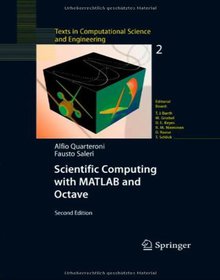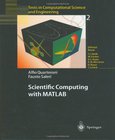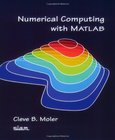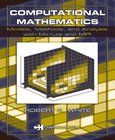Scientific Computing with MATLAB and Octave
2nd Edition

Book Details:
| Publisher: | Springer |
| Series: | Springer |
| Author: | Alfio Quarteroni |
| Edition: | 2 |
| ISBN-10: | 354032612X |
| ISBN-13: | 9783540326120 |
| Pages: | 318 |
| Published: | Oct 05 2006 |
| Posted: | Nov 19 2014 |
| Language: | English |
| Book format: | |
| Book size: | 7.38 MB |
Book Description:
This textbook is an introduction to Scientific Computing, in which several numerical methods for the computer solution of certain classes of mathematical problems are illustrated. The authors show how to compute the zeros or the integrals of continuous functions, solve linear systems, approximate functions by polynomials and construct accurate approximations for the solution of ordinary and partial differential equations. To make the presentation concrete and appealing, the programming environments Matlab and Octave, whichis freely distributed, are adopted as faithful companions. The book contains the solutions to several problems posed in exercises and examples, often originating from specific applications. A specific section is devoted to subjects which were not addressed in the book and contains the bibliographical references for a more comprehensive treatment of the material. The second edition features many new problems and examples, as well as more numerical methods for linear and nonlinear systems and ordinary and partial differential equations. This book is presently being translated or has appeared in the following languages: Italian, German, French, Chineseand Spanish. Reviews for "Scientific Computing with MATLAB" - 1st edition: " ... Scientific Computing with MATLAB is written in a clear and concise style, figures, tables and formula boxes complement the explanations... The whole book is an invitation, if not a request, of the authors to the reader to play with MATLAB, apply its powerful menagerie of functions to solve the given (or own) problems - in brief, supervised learning by doing .... is a stimulating introductory textbook about numerical methods that successfully combines mathematical theory with programming experience..." Anselm A.C. Horn, Journal of Molecular Modeling 2004 "... An excellent addition to academic libraries and university bookstores, this book will be useful for self-study and as a complement to other MATLAB-based books. Highly recommended. Upper-division undergraduates through professionals." S.T. Karris, Choice 2003
Download Link:
Related Books:
Scientific Computing with MATLAB
This textbook is an introduction to Scientific Computing, in which several numerical methods for the computer solution of certain classes of mathematical problems are illustrated. The authors show how tocompute the zeros or the integrals of continuous functions, solve linear systems, approximate functions by polynomials and construct accurate approximations for thesolution of differential equations. To make the presentation concrete and appealing, the programming environmentMatlab is adopted as a faithful companion. All the algorithms introduced throughout the bookare shown, thus furnishing an immediate quantitative assessment of their theoretical properties such as stability, accuracy and complexity. The book also contains the solution to several pr...
Numerical Computing with Matlab
This is a lively textbook for an introductory course in numerical methods, MATLAB, and technical computing, with an emphasis on the informed use of mathematical software. The presentation helps readers learn enough about the mathematical functions in MATLAB to use them correctly, appreciate their limitations, and modify them appropriately. The book makes extensive use of computer graphics, including interactive graphical expositions of numerical algorithms. It provides more than 70 M-files, which can be downloaded from the text Web site www.mathworks.com/moler. Many of the numerous exercises involve modifying and extending these programs. The topics covered include an introduction to MATLAB; linear equations; interpolation; zeros and roots; least squ...
Computational Mathematics
Models, Methods and Analysis with MATLAB and MPI
Computational Mathematics: Models, Methods, and Analysis with MATLAB and MPI explores and illustrates this process. Each section of the first six chapters is motivated by a specific application. The author applies a model, selects a numerical method, implements computer simulations, and assesses the ensuing results. These chapters include an abundance of MATLAB code. By studying the code instead of using it as a "black box, " you take the first step toward more sophisticated numerical modeling. The last four chapters focus on multiprocessing algorithms implemented using message passing interface (MPI). These chapters include Fortran 9x codes that illustrate the basic MPI subroutines and revisit the applications of the previous chapters from...
2007 - 2021 © eBooks-IT.org



